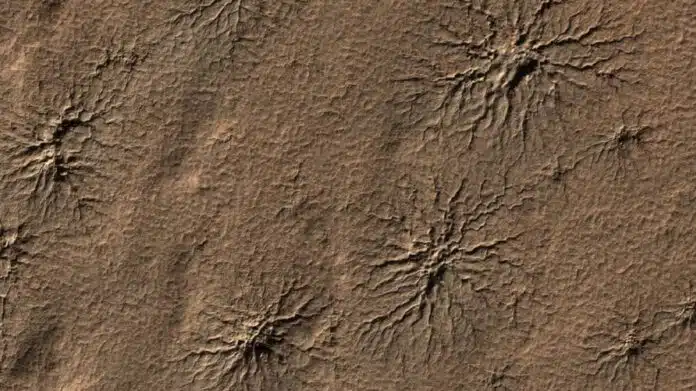
By Pranjal Malewar 19 Sep, 2024
Collected at: https://www.techexplorist.com/nasa-scientists-recreated-mars-spiders-lab/89945/
Scientists are amazed by spider-like shapes on the southern part of Mars. No one knows precisely how these formed. Each one can be over half a mile long and has many thin “legs.” These are known as araneiform terrain, and they often appear in groups, making the surface look wrinkled.
Now, NASA scientists have re-created those formation processes in simulated Martian temperatures and air pressure for the first time. The experiments could help tune the models for how they form.
The study confirms how spider-like shapes form on Mars based on the Kieffer model. Sunlight heats the soil through clear carbon dioxide ice that forms in winter. The darker soil absorbs heat, causing the ice to turn directly into gas in sublimation. As the gas builds up, it cracks the ice and escapes, carrying dark dust and sand from the soil onto the ice surface.
When winter ends and the ice sublimates, the leftover scars from these small eruptions create spider-like features.
The challenging part of conducting these experiments was re-creating conditions found on the Martian polar surface—extremely low air pressure and temperatures as low as minus 301 degrees Fahrenheit (minus 185 degrees Celsius). They used a liquid-nitrogen-cooled test chamber at JPL called the Dirty Under-vacuum Simulation Testbed for Icy Environments, or DUSTIE.
Lauren Mc Keown of NASA’s Jet Propulsion Laboratory in Southern California said, “I love DUSTIE. It’s historic; the wine barrel-size chamber was used to test a prototype of a rasping tool designed for NASA’s Mars Phoenix lander. The tool was used to break water ice, which the spacecraft scooped up and analyzed near the planet’s north pole.”

For this experiment, researchers chilled Martian soil simulant in a container placed in a liquid nitrogen bath. They then put it in the DUSTIE chamber, reducing the air pressure to match Mars’ southern hemisphere. Carbon dioxide flowed into the chamber and turned into ice over three to five hours. McKeown took many tries to find the right conditions to make the ice thick and clear enough.
Once they had the right ice, they placed a heater below the simulant to warm it and crack it. McKeown was thrilled when she saw carbon dioxide gas erupting from the simulant.
The dark plumes created holes in the simulant as they burst out, continuing for up to 10 minutes until all the gas was released.
The experiments revealed something unexpected not included in the Kieffer model: Ice formed between the grains of the simulant and cracked it open. This might explain why the spider shapes appear more “cracked.” Whether this happens depends on the size of the soil grains and how much water ice is buried.
Now, scientists known the condition behind plumes formation, the next step is to try the same experiments with simulated sunlight from above, rather than using a heater below. This will help scientists determine several conditions under which the plumes and ejection of soil might occur.
Journal Reference:
- Lauren E. Mc Keown, Michael Poston et al. A Lab-scale Investigation of the Mars Kieffer Model. The Planetary Science Journal. DOI 10.3847/PSJ/ad67c8

Leave a Reply